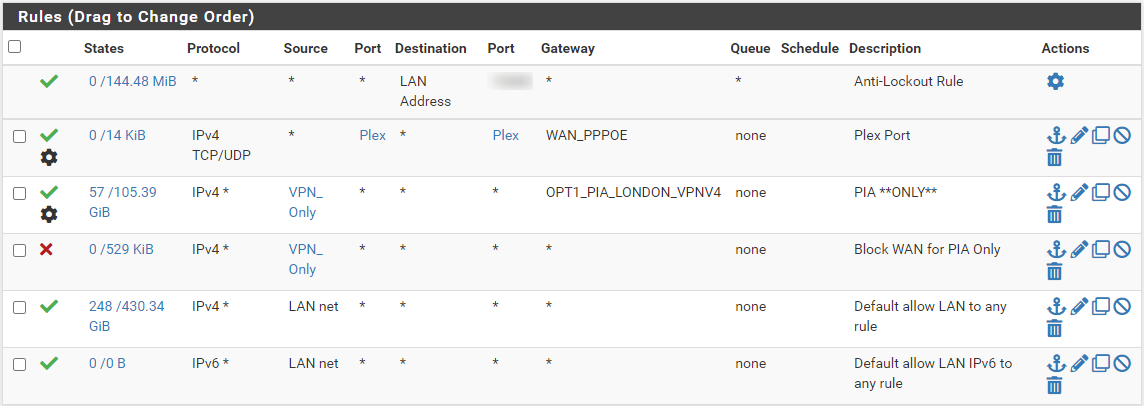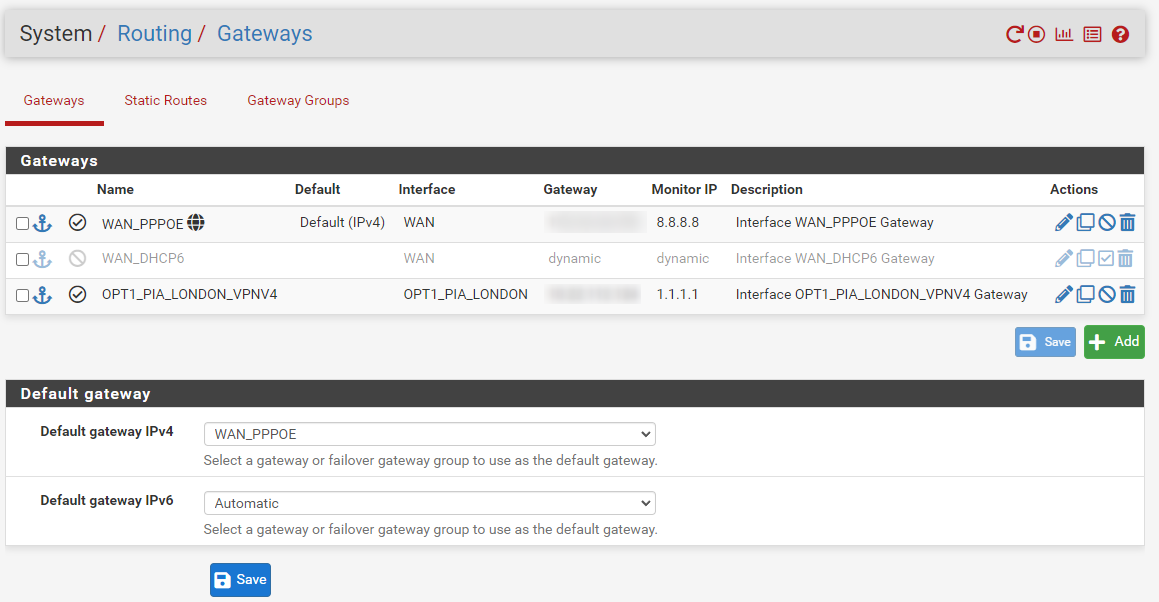Bypass VPN using Port
-
@lockie
Does it work in any case, apart from policy routing? -
@viragomann I don't know what you mean?
My initial question was how can I route traffic from a single IP and Port to WAN instead of VPN. I don't know what works because I've not got it working.
What I have working is routing traffic based on an IP to VPN.
-
@viragomann as an additional note I can see that when testing Plex via its interface. It's still using a Public IP of the VPN and not of the WAN. So I assume the traffic is not getting forwarded correctly to the WAN instead of the VPN based on the port.
-
@lockie
So I suspect, the you have the default route pointing to the VPN gateway. This might not be that what you want indeed, since you set up a policy routing rule for the VPN.To investigate, please post the IPv4 routing table.
-
-
@lockie
Diagnostics > Routes -
@viragomann Sorry there's lots of private info in there. Is there something you're looking for in particular? I do want to share, I just don't want all my IP's on here :)
-
@lockie said in Bypass VPN using Port:
Sorry there's lots of private info in there.
Private infos? Private IPs?
There should be routes at all.
There is no need to hide private IPs, but public ones possibly.Particularly I'd like to check the route pointing to the VPN gateway.
-
What does this plex port do, what is the destination?
-
-
@bob-dig
See here:
https://support.plex.tv/articles/201543147-what-network-ports-do-i-need-to-allow-through-my-firewall/*The most important port to make sure your firewall allows is the main TCP port the Plex Media Server uses for communication:
TCP: 32400 (access to the Plex Media Server) [required]*
-
@lockie
There is not any route pointing to a VPN gateway at all.
So basically all upstream traffic should be directed to the WAN gateway, as long as the policy route is not applied to it.Hence the only reason for going out to the VPN, I can think of, is that the packets are caught by the policy routing rule.
This would mean, that the "Plex" rule is not applied to it, while the PIA rule is. -
@lockie I am not using plex and it is unclear to me what this port is good for. But maybe you first should create an rfc1819 alias and put it in your vpn rule as an inverted destination.
-
I don't really understand what this fully means and the result of it that I should look to execute
-
@lockie said in Bypass VPN using Port:
See here:
https://support.plex.tv/articles/201543147-what-network-ports-do-i-need-to-allow-through-my-firewall/These ports seems to be incoming ports on the Plex media server. So they cannot be used in the outbound rule.
-
Okay. I'll try and ask my question a bit differently.
I'm a beginner in terms of Networking and don't have an understanding of all things networking.
I have a single device and I have a router with pfSense. What I'd like to achieve via the router is that almost all traffic on that device goes via a VPN. However, one application on that device (called Plex) needs to be outside that VPN.
How can I achieve this?
Thank you
-
@lockie
Filter rules can only determine protocols, IPs and ports.
So either get out the destination IP or port you need. Then you can use it in the rule.Since we are bloody newbies on Plex, we don't know it.

-
@lockie said in Bypass VPN using Port:
How can I achieve this?
Thank you
@bob-dig said in Bypass VPN using Port:
. But maybe you first should create an rfc1819 alias and put it in your vpn rule as an inverted destination.
-
@bob-dig
Sorry I don't know what this means. Is there a guide on this? -
@bob-dig
Tried to follow this https://docs.netgate.com/pfsense/en/latest/recipes/rfc1918-egress.htmlBut I seem to get:
Subnet is too large to expand into individual host IP addresses (192.168.0.0/8)
The maximum number of entries in an alias is 5000
192.168.0.0/8 is not a valid address, FQDN or alias.

